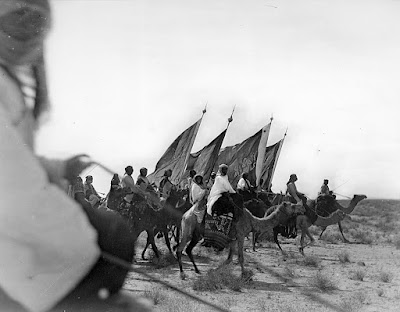Formation of Modern Saudi Arabia - History and Significance
Modern-day
Saudi Arabia is a vast country, established in 1932 after the unification of the majority areas of the Arabian peninsular under the rule of the al-Saud family. Modern
Saudi Arabia is also the Third
Saudi State because Saudis established two previous states in
the 18th and 19th centuries. Saudis gained influence through the Salafi
ideology of Islam, which is quite similar to the Puritan faith of the Christian religion.
Brief
History
Muhammad bin Abdul Wahhab (1703-1792) was a famous preacher
and religious scholar of Najd (central
Arabia). The basis of his teachings is on strict Islamic beliefs, where the
emphasis is on the propagation of Tawheed (monotheism)
and rejection of shirk (polytheism), bidah (innovations in Islam), and
supplication from anyone except Allah. Ibn-e-Saud's family accepted his religious ideology, and later both families allied. Under an agreement, Ibn
Abdul Wahhab accepted the political supremacy of the al-Saud family in their captured areas, and the al-Saud family recognized the religious
authority of the Ibn Abdul Wahhab family (known as al-Shaikh). Mutual marriages between the two families further strengthened their ties.
The
alliance proved fruitful, and the First
Saudi State was founded in 1744, which comprised modern Saudi Arabia and a few other neighboring countries. The Ottomans
ended this First Saudi State in 1818 with the help of their viceroy in Egypt.
In 1824,
Saudis established the Second
Saudi State, but it was limited to the Najd area around their stronghold Diriyyah. This time, the Al Rashid family of Najd defeated them
in 1891 and forced the exile of the Saudis to Kuwait.
Third Saudi
State
In 1902,
the formation of the Third Saudi State started
with the recapture of Riyadh by Abdul Aziz bin Saud (also known as Ibn-e-Saud). Ikhwan (brotherhood) was a tribal army of Najd, famous for their
religious zeal and bravery. The Saudis founded this religiously motivated force in 1912. This tribal army helped the Saudis capture Al-Hasa (the eastern
region of Arabia) from the Ottomans in 1913. In 1921, Saudis and Ikhwan defeated
the Al Rashid family and became the sole rulers of the central Arabian area of
Najd.
Hussain bin Ali (known as Sharif of Makkah) revolted against the Ottomans during World War 1 with the help of the British Empire. He aimed to form a united
Arabian state, but the Saudis defeated him in 1925 and took control of the area
of Hejaz.
Later, the Ikhwan also became a nuisance for the
Saudis as they tried to expand the religious ideology to the states under the
protection of the British, including Kuwait, Iraq, and Transjordan. It was like
declaring war against the superpower British Empire and thus not accepted by
the Saudis. This difference and a few internal matters turned the zealous Ikhwan against the
Saudis and brought their downfall at the Battle of Sabilla in 1930.
In 1932, the Saudis united the areas of Hejaz and Najd to form a single state, naming it al-Mumlikaht-ul-Arabiyah-as-Saudiyah
(Kingdom of Saudi Arabia or KSA).
King Abdul Aziz bin Saud became the first ruler of the modern Saudi State.
Importance
Radical Sunni Islam (Salafism or Wahhabism) played a vital role in the foundation of Saudi Arabia. The modern Saudi state was fortunate due to the discovery of large oil
and gas reserves in 1938. This wealth helped the Saudi state not only to give prosperity to the nation and its citizens but also make it possible for them to spread the
Salafi ideology of Islam in other Muslim and non-Muslim countries.
In the
1980s, Saudi Arabia increased its influence rapidly and passionately after the
occupation of Afghanistan by Soviet Russia and the Revolution in Iran (the formation of Shia religious authority in place
of a secular monarchy). The latter event resulted in sectarian conflicts in the Muslim world, with Saudi Arabia and Iran becoming leaders of opposite sides. This conflict is evident now in Iraq, Syria, and several other countries. The
emergence of al-Qaida and ISIS (Islamic State of Iraq and Syria/Sham)
in modern times is also the outcome of these religious and sectarian
conflicts.
Saudi Arabia
used its wealth and religious authority to influence the Middle East and other
parts of the world. It played a significant role in different conflicts regarding the Muslim world. These include the Arab-Israel wars, the Soviet Occupation of Afghanistan, the liberation of Bosnia from Yugoslavia, etc. Saudi Arabia is also at the forefront of spreading Islam in non-Muslim countries and purifying Islam from un-Islamic rituals in different Muslim countries.


Comments
Post a Comment